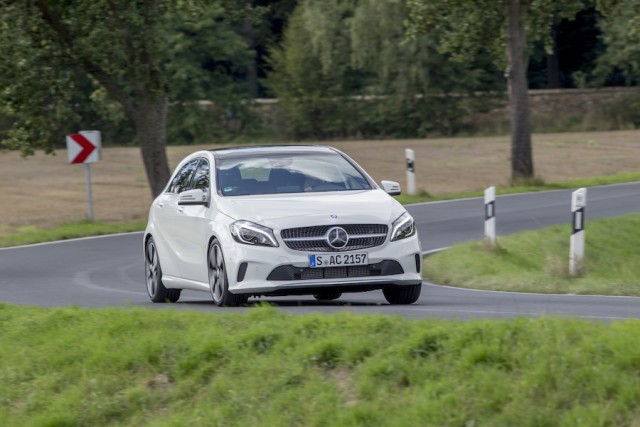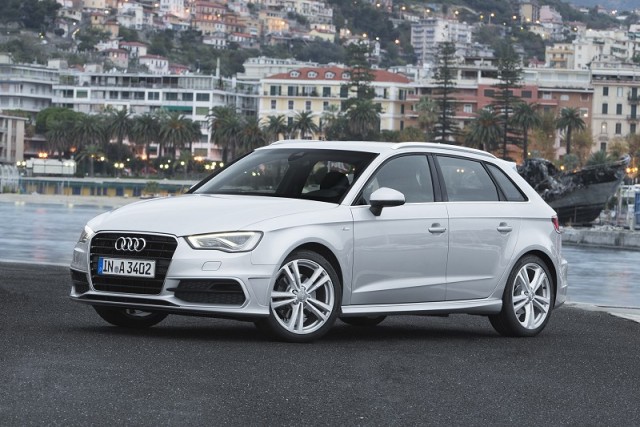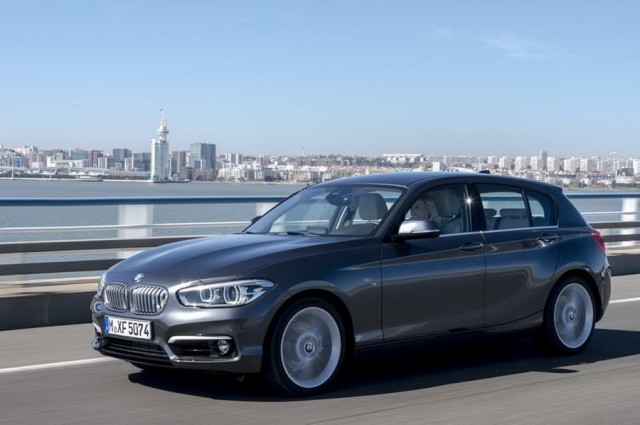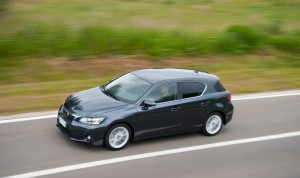Visually, there's little different to note about the 2016MY Mercedes-Benz A-Class, as it's a very mild facelift outside and in for the third generation of Stuttgart's smallest car. But hidden in the options list is something that makes this car worth fresh attention: adaptive damping can be fitted and, if chosen, turns the formerly hard-riding A-Class into one of the segment's main contenders.
In the metal 4.5/5
It's another of those minimalistic facelifts we're seeing from the car manufacturers at the moment. Used to be that when a car came in for a mid-life update, the visual changes were easy to spot - think of Ford Escorts back in the day that got entirely new grille shapes and headlamp clusters, or the pre-2000s BMWs, where the 'life-cycle impulse' saw bigger kidney grilles, totally new lights and often clear indicator lenses among a raft of updates.
So good luck spotting the fact this is the new Mercedes-Benz A-Class. No, go on - be our guests. We'll sit here for a few seconds while you attempt to circle the differences between this and a 2012 model... give in? OK, look for very marginally tweaked headlight and rear lamp clusters, subtly reshaped bumpers all round and a diamond-pattern front grille. There are new colours on offer, especially the excellent Elbaite Green, but other than that this looks just like the A-Class we've all known and loved... well, liked, since 2012. The interior's the same story: new trim finishes and hues, plus some comfier seats, but unless you're a diehard Stuttgart aficionado you'll be hard pressed to notice the upgrades from a pre-facelift model.
None of this is hugely dispiriting, as the third-gen A-Class has always been a handsome vehicle with a high-quality interior. The only problems within remain the wilfully individualistic ergonomics that Mercedes insists on sticking with (column shift gear lever for the auto; lights, wipers and indicators all on one stalk to the left of the wheel, meaning the unfamiliar driver will often flash the car ahead instead of washing the windscreen; the cruise control column just below that, ready for inadvertent activation), the slightly cumbersome controls for the infotainment system and that display screen mounted seemingly as an afterthought centre-top of the dash (the tablet is seven inches on base models, eight inches on higher-spec cars). However, there's enough space for four adults and a decent boot out back, although the Audi A3 Sportback has its measure here - it has 380 litres of cargo space, rising to 1,220 litres with the seats folded down, to the Merc's 341/1,157 litres.
There's some good news on the spec sheet, though, in the form of two additions: the first is the Dynamic Select drive modes setting on most of the line-up (basic cars do without it), but it's the second, a cost option, which is the best facet of the facelift. Two-stage adaptive damping is now available for the A-Class and it brings some significant improvements to the whole package, which we'll come on to right now...
Driving it 3.5/5
This is the important A 220 d model, now bearing the new single-letter badge suffix (CDI has bit the dust) and toting an extra 7hp than before at 177hp all-in. A lesser-powered 136hp variant of this engine is offered in the A 200 d, while a smaller 1.6-litre unit with 109hp can be found under the nose of the A 180 d. The A 220 d is automatic only but it can be specified with 4Matic all-wheel drive, although we'd advocate steering clear of it as it has a big impact on economy and emissions - the four-wheel drive 2.1 diesel will set you back an extra €80 road tax a year as it sits in Band B1.
So, instead of throwing that cash at largely superfluous all-wheel grip, treat yourself to the selectable damping instead. You can set them to either Comfort or Sport, but as they are truly adaptive items - rather than switchable - the car will firm things up if you start driving hard in Comfort mode, or slacken things off if you throttle back with Sport engaged. And cruising in Comfort, the A-Class has an exemplary ride. The preceding model was always a bit fidgety and nervous, making a meal of transverse ridges and major vertical load inputs, yet the new car soothes away almost all the road surface detail beneath the Merc's tyres. It's not quite perfect; the secondary ride is still perceptible. But an adaptive damper-equipped A-Class is now a major rival for the class leaders in terms of ride comfort, which can only be a good thing.
The rest of the driving experience, in this diesel model at least, is so-so: the steering is good but not great, the brakes are strong and crisp and the DCT automatic gearbox works unobtrusively. Wind noise around the A-pillars becomes noticeable at motorway speeds but it doesn't really spoil the generally refined steady-state driving demeanour. Press on in the A 220 d and it proves to have reasonable grip with a dearth of body roll, if not one that'll ever reveal a more mischievous dynamic side.
The main bugbear is that ageing 2.1-litre diesel engine, which really needs to be retired soon. It's been hanging around since 2008 and it is much more vocal and harsh at higher revs than rival powerplants from the Volkswagen Group and BMW, and even 2.0-litre units from Ford and Opel. No question it's punchy, the twin-turbo motor easily coping with the A 220 d's sub-1.5-tonne kerb weight, but the gargling noise of it never quite dies away enough on a trailing throttle. On the moderate launch test route, we also saw 6.6 litres/100km (42.8mpg), some way off the official figure without us tanking the A 220 d on the rev limiter everywhere.
What you get for your money 4/5
Mercedes is claiming a lot of additional standard equipment, thus improving the customer's value-for-money offering. New standard items include keyless start, a reversing camera, cruise control and heated front seats, in total adding up to about €1,560. That's pretty good given the modest (below two per cent) price increases. The entry-level car is the petrol-fuelled A 160, while the diesel range starts at €28,940 with the A 160d. The A 220d tested here is not expected to be one of the most popular models. Coinciding with the launch of the new A-Class in Ireland is the firm's introduction of a new PCP finance scheme. With a 3.9 per cent APR rate, the new A-Class starts at €298 per month.
Summary
We've always liked the look of the Mercedes A-Class and while we lament the lack of adventure on the part of Stuttgart's stylists when it came to facelift time, we also concede that the car remains a handsome bit of kit, both inside and out. The A 220 d is a fine all-rounder of a premium hatchback, its 2.1-litre engine, which is raucous compared to prevailing class standards, aside, but with adaptive damping fitted the A-Class proves to be just as good at covering great distance in top-level comfort as the best in the segment. For that reason, it's a very worthwhile update on Mercedes' part.





